Page 338 of 440
3387-3. Do-it-yourself maintenance
AYGO_EE_OM99J92E
Reinstall the license plate
lights as shown in the illustra-
tion.
Align the notches and claws on
the license plate lights with the
mounting when installing.
■High mounted stoplight
Push the upper springs using
the flathead screwdriver and
remove the high mounted
stoplight assembly.
To prevent damage, cover the
tip of the flathead screwdriver
with rag.
Remove the bulb base.
5
Spring
Springs
1
2
Page 339 of 440
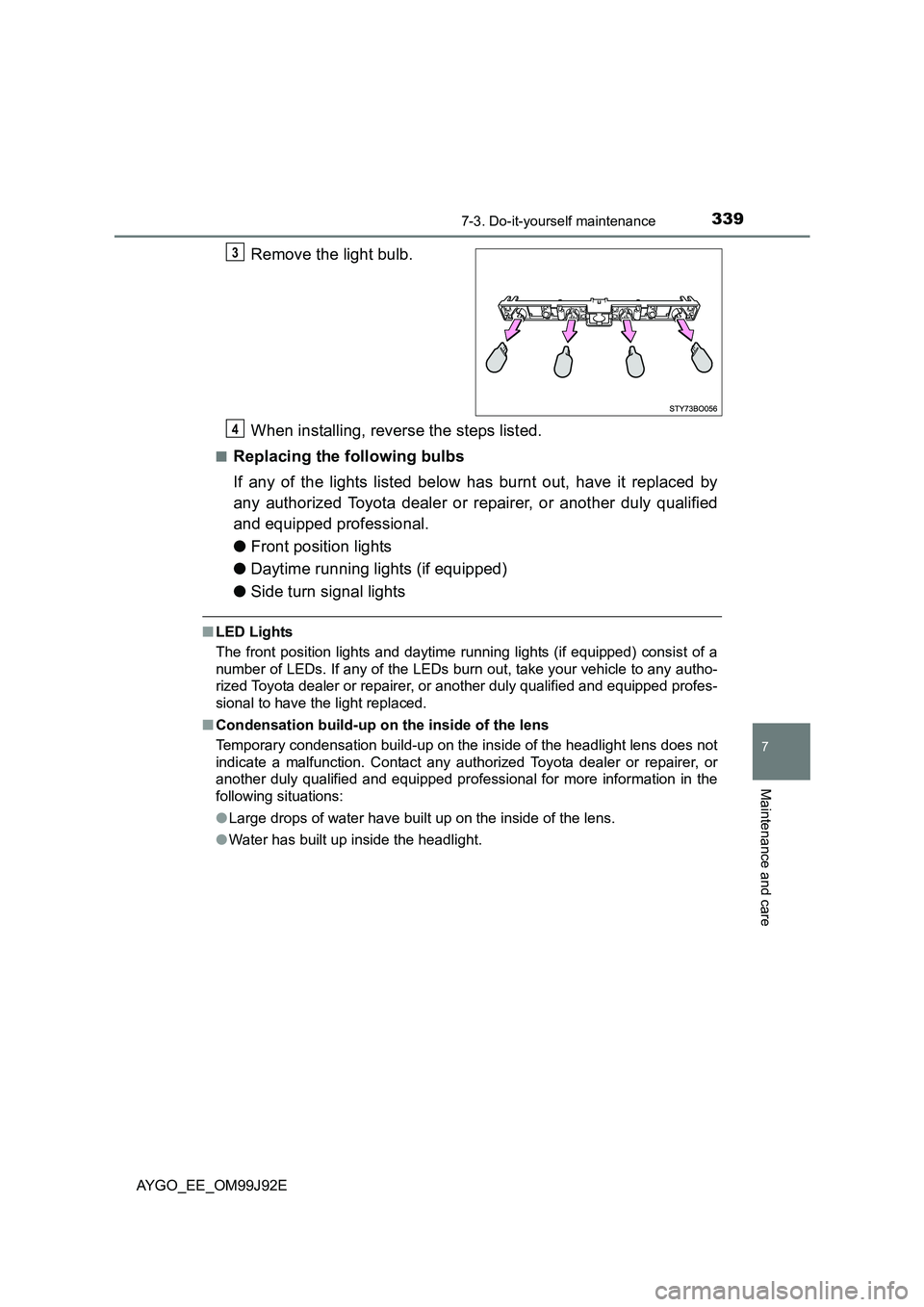
3397-3. Do-it-yourself maintenance
7
Maintenance and care
AYGO_EE_OM99J92E
Remove the light bulb.
When installing, reverse the steps listed.
■Replacing the following bulbs
If any of the lights listed below has burnt out, have it replaced by
any authorized Toyota dealer or repairer, or another duly qualified
and equipped professional.
● Front position lights
● Daytime running lights (if equipped)
● Side turn signal lights
■LED Lights
The front position lights and daytime running lights (if equipped) consist of a
number of LEDs. If any of the LEDs burn out, take your vehicle to any autho-
rized Toyota dealer or repairer, or another duly qualified and equipped profes-
sional to have the light replaced.
■ Condensation build-up on the inside of the lens
Temporary condensation build-up on the inside of the headlight lens does not
indicate a malfunction. Contact any authorized Toyota dealer or repairer, or
another duly qualified and equipped professional for more information in the
following situations:
● Large drops of water have built up on the inside of the lens.
● Water has built up inside the headlight.
3
4
Page 340 of 440
3407-3. Do-it-yourself maintenance
AYGO_EE_OM99J92E
WARNING
■ Replacing light bulbs
● Turn off the lights. Do not attempt to replace the bulb immediately after
turning off the lights.
The bulbs become very hot and may cause burns.
● Do not touch the glass portion of the light bulb with bare hands. When it is
unavoidable to hold the glass portion, use and hold with a clean dry cloth
to avoid getting moisture and oils on the bulb.
Also, if the bulb is scratched or dropped, it may blow out or crack.
● Fully install light bulbs and any parts used to secure them. Failure to do so
may result in heat damage, fire, or water entering the headlight unit. This
may damage the headlights or cause condensation to build up on the lens.
■ To prevent damage or fire
● Make sure bulbs are fully seated and locked.
● Check the wattage of the bulb before installing to prevent heat damage.
Page 352 of 440
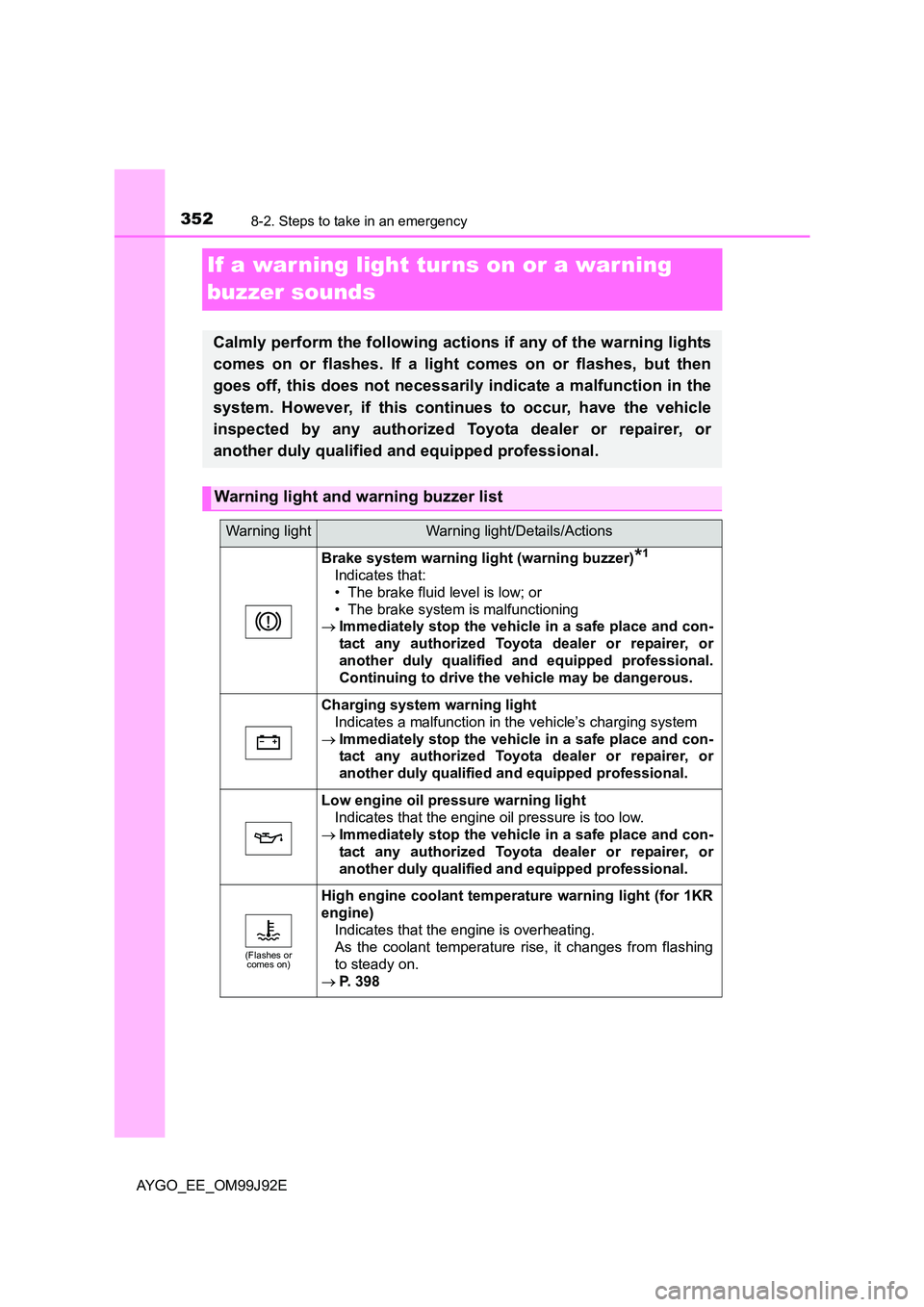
3528-2. Steps to take in an emergency
AYGO_EE_OM99J92E
If a war ning light tur ns on or a warning
buzzer sounds
Calmly perform the following actions if any of the warning lights
comes on or flashes. If a light comes on or flashes, but then
goes off, this does not necessarily indicate a malfunction in the
system. However, if this continues to occur, have the vehicle
inspected by any authorized Toyota dealer or repairer, or
another duly qualified and equipped professional.
Warning light and warning buzzer list
Warning lightWarning light/Details/Actions
Brake system warning light (warning buzzer)*1
Indicates that:
• The brake fluid level is low; or
• The brake system is malfunctioning
→ Immediately stop the vehicle in a safe place and con-
tact any authorized Toyota dealer or repairer, or
another duly qualified and equipped professional.
Continuing to drive the vehicle may be dangerous.
Charging system warning light
Indicates a malfunction in the vehicle’s charging system
→ Immediately stop the vehicle in a safe place and con-
tact any authorized Toyota dealer or repairer, or
another duly qualified and equipped professional.
Low engine oil pressure warning light
Indicates that the engine oil pressure is too low.
→ Immediately stop the vehicle in a safe place and con-
tact any authorized Toyota dealer or repairer, or
another duly qualified and equipped professional.
(Flashes or comes on)
High engine coolant temperature warning light (for 1KR
engine)
Indicates that the engine is overheating.
As the coolant temperature rise, it changes from flashing
to steady on.
→ P. 398
Page 355 of 440
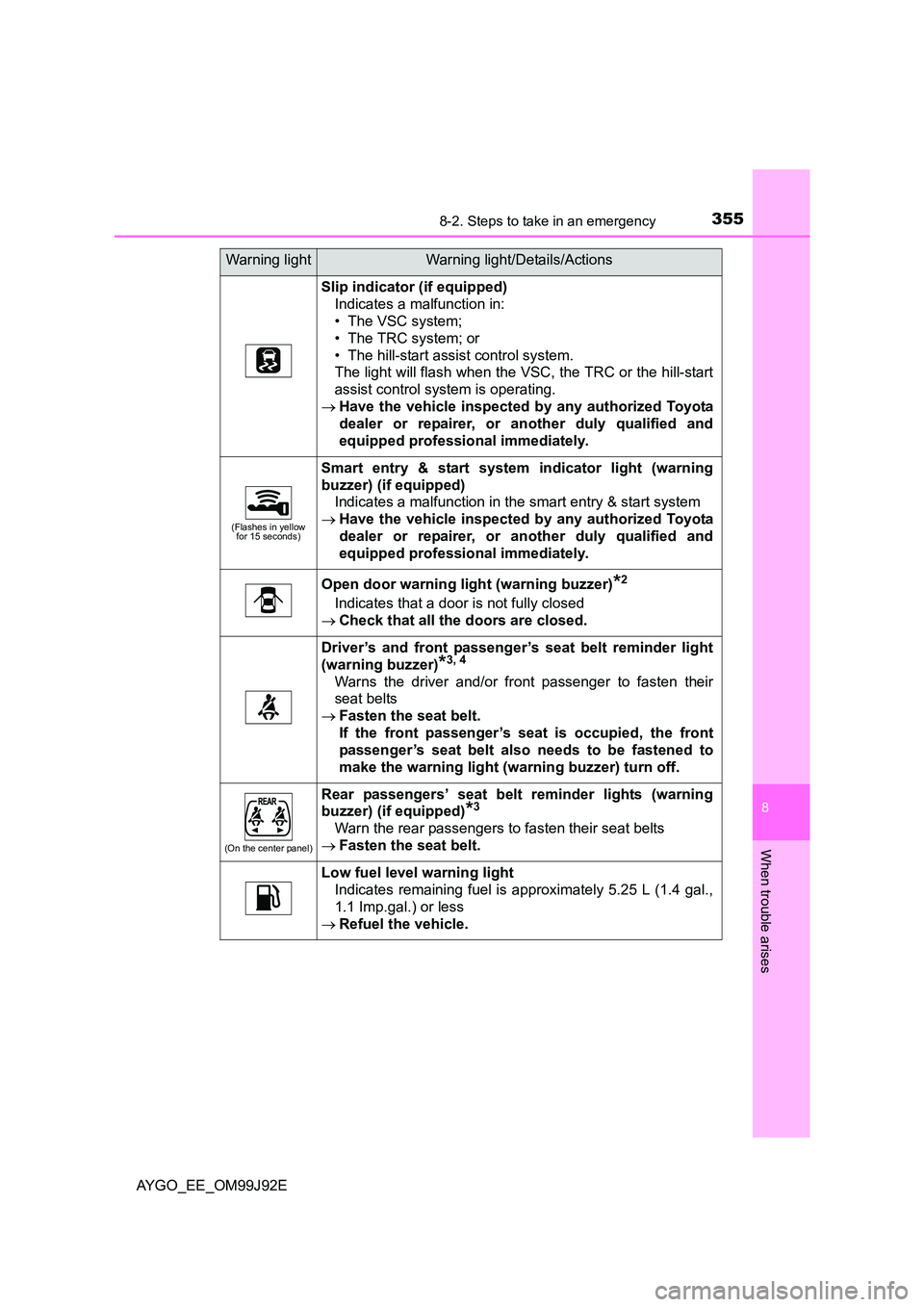
3558-2. Steps to take in an emergency
8
When trouble arises
AYGO_EE_OM99J92E
Slip indicator (if equipped)
Indicates a malfunction in:
• The VSC system;
• The TRC system; or
• The hill-start assist control system.
The light will flash when the VSC, the TRC or the hill-start
assist control system is operating.
→ Have the vehicle inspected by any authorized Toyota
dealer or repairer, or another duly qualified and
equipped professional immediately.
(Flashes in yellow for 15 seconds)
Smart entry & start system indicator light (warning
buzzer) (if equipped)
Indicates a malfunction in the smart entry & start system
→ Have the vehicle inspected by any authorized Toyota
dealer or repairer, or another duly qualified and
equipped professional immediately.
Open door warning light (warning buzzer)*2
Indicates that a door is not fully closed
→ Check that all the doors are closed.
Driver’s and front passenger’s seat belt reminder light
(warning buzzer)*3, 4
Warns the driver and/or front passenger to fasten their
seat belts
→ Fasten the seat belt.
If the front passenger’s seat is occupied, the front
passenger’s seat belt also needs to be fastened to
make the warning light (warning buzzer) turn off.
(On the center panel)
Rear passengers’ seat belt reminder lights (warning
buzzer) (if equipped)*3
Warn the rear passengers to fasten their seat belts
→ Fasten the seat belt.
Low fuel level warning light
Indicates remaining fuel is approximately 5.25 L (1.4 gal.,
1.1 Imp.gal.) or less
→ Refuel the vehicle.
Warning lightWarning light/Details/Actions
Page 358 of 440
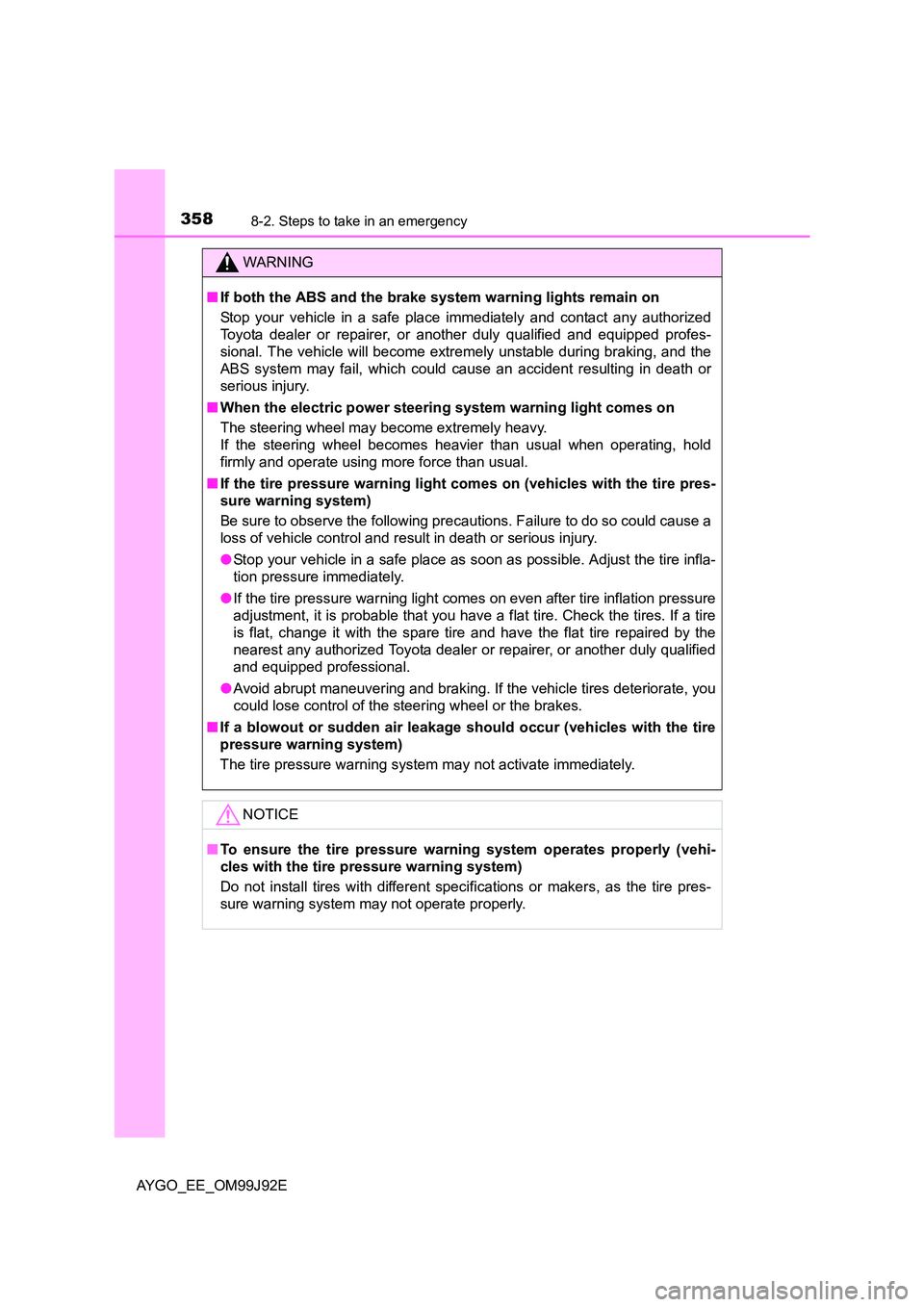
3588-2. Steps to take in an emergency
AYGO_EE_OM99J92E
WARNING
■ If both the ABS and the brake system warning lights remain on
Stop your vehicle in a safe place immediately and contact any authorized
Toyota dealer or repairer, or another duly qualified and equipped profes-
sional. The vehicle will become extremely unstable during braking, and the
ABS system may fail, which could cause an accident resulting in death or
serious injury.
■ When the electric power steering system warning light comes on
The steering wheel may become extremely heavy.
If the steering wheel becomes heavier than usual when operating, hold
firmly and operate using more force than usual.
■ If the tire pressure warning light comes on (vehicles with the tire pres-
sure warning system)
Be sure to observe the following precautions. Failure to do so could cause a
loss of vehicle control and result in death or serious injury.
● Stop your vehicle in a safe place as soon as possible. Adjust the tire infla-
tion pressure immediately.
● If the tire pressure warning light comes on even after tire inflation pressure
adjustment, it is probable that you have a flat tire. Check the tires. If a tire
is flat, change it with the spare tire and have the flat tire repaired by the
nearest any authorized Toyota dealer or repairer, or another duly qualified
and equipped professional.
● Avoid abrupt maneuvering and braking. If the vehicle tires deteriorate, you
could lose control of the steering wheel or the brakes.
■ If a blowout or sudden air leakage should occur (vehicles with the tire
pressure warning system)
The tire pressure warning system may not activate immediately.
NOTICE
■ To ensure the tire pressure warning system operates properly (vehi-
cles with the tire pressure warning system)
Do not install tires with different specifications or makers, as the tire pres-
sure warning system may not operate properly.
Page 388 of 440
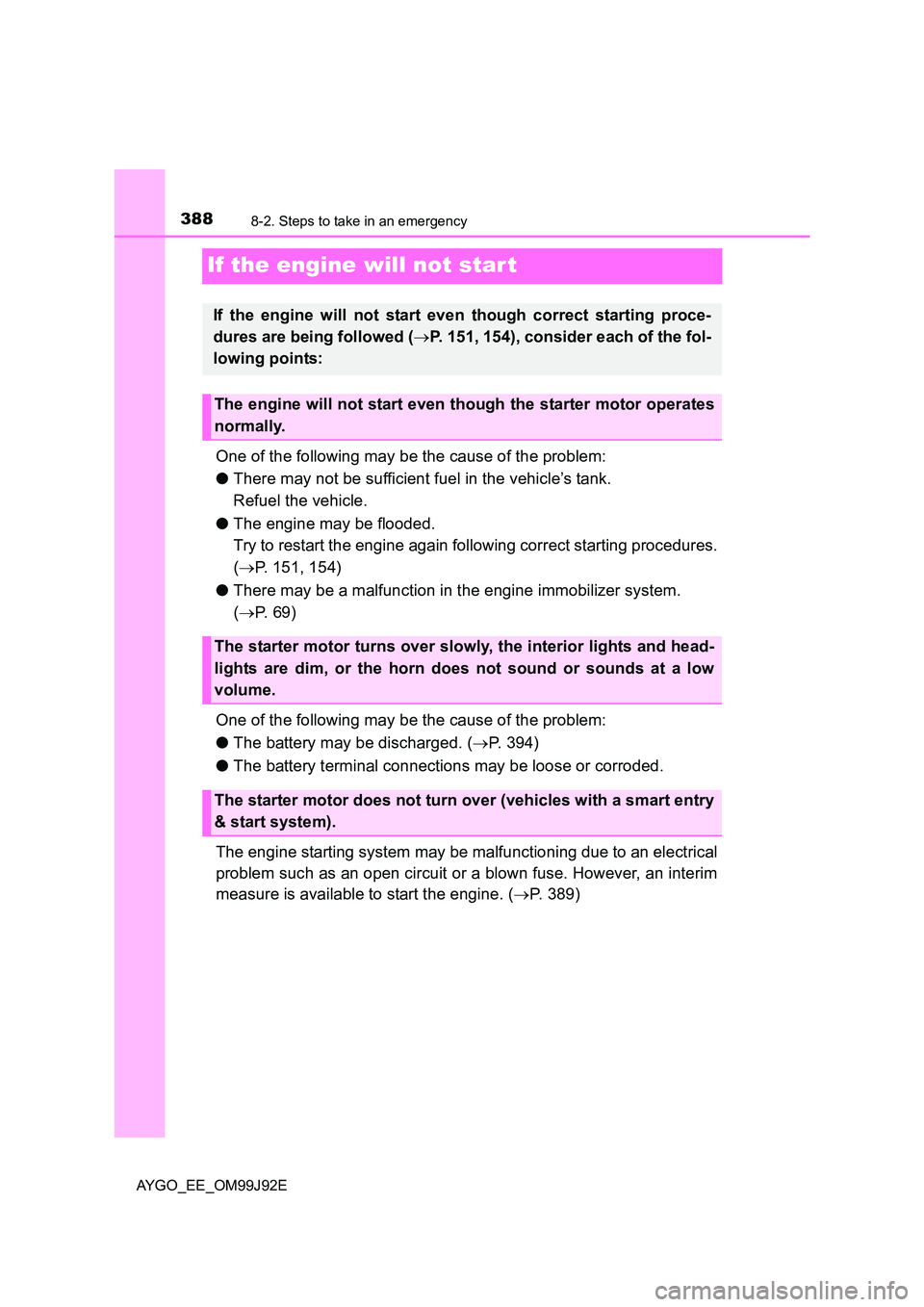
3888-2. Steps to take in an emergency
AYGO_EE_OM99J92E
If the engine will not star t
One of the following may be the cause of the problem:
● There may not be sufficient fuel in the vehicle’s tank.
Refuel the vehicle.
● The engine may be flooded.
Try to restart the engine again following correct starting procedures.
( →P. 151, 154)
● There may be a malfunction in the engine immobilizer system.
( →P. 6 9 )
One of the following may be the cause of the problem:
● The battery may be discharged. (→P. 394)
● The battery terminal connections may be loose or corroded.
The engine starting system may be malfunctioning due to an electrical
problem such as an open circuit or a blown fuse. However, an interim
measure is available to start the engine. ( →P. 389)
If the engine will not start even though correct starting proce-
dures are being followed ( →P. 151, 154), consider each of the fol-
lowing points:
The engine will not start even though the starter motor operates
normally.
The starter motor turns over slowly, the interior lights and head-
lights are dim, or the horn does not sound or sounds at a low
volume.
The starter motor does not turn over (vehicles with a smart entry
& start system).
Page 389 of 440
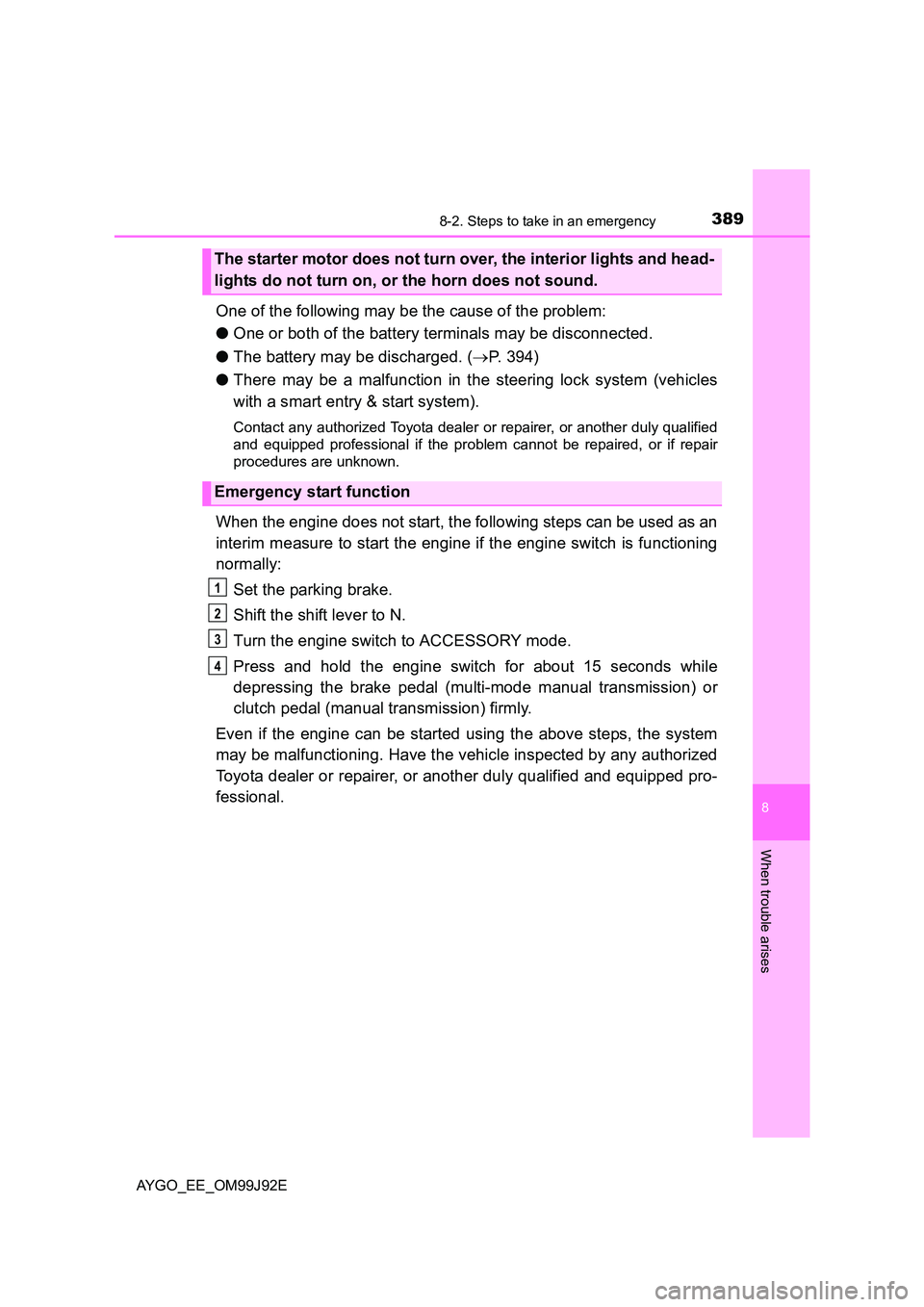
3898-2. Steps to take in an emergency
8
When trouble arises
AYGO_EE_OM99J92E
One of the following may be the cause of the problem:
● One or both of the battery terminals may be disconnected.
● The battery may be discharged. (→P. 394)
● There may be a malfunction in the steering lock system (vehicles
with a smart entry & start system).
Contact any authorized Toyota dealer or repairer, or another duly qualified
and equipped professional if the problem cannot be repaired, or if repair
procedures are unknown.
When the engine does not start, the following steps can be used as an
interim measure to start the engine if the engine switch is functioning
normally:
Set the parking brake.
Shift the shift lever to N.
Turn the engine switch to ACCESSORY mode.
Press and hold the engine switch for about 15 seconds while
depressing the brake pedal (multi-mode manual transmission) or
clutch pedal (manual transmission) firmly.
Even if the engine can be started using the above steps, the system
may be malfunctioning. Have the vehicle inspected by any authorized
Toyota dealer or repairer, or another duly qualified and equipped pro-
fessional.
The starter motor does not turn over, the interior lights and head-
lights do not turn on, or the horn does not sound.
Emergency start function
1
2
3
4